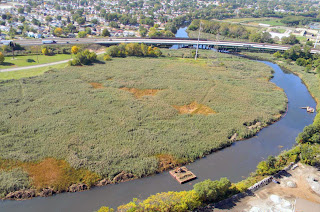“Work will start April 22 on a project that will dredge (remove) or cap (isolate from the ecosystem) 1.2 million cubic yards of river bottom sediment contaminated with PAHs, oil & grease, PCBs, and heavy metals like cadmium and copper. Volume-wise, this would fill about 300 Olympic-sized swimming pools. Along with restoration of more than 50 acres of wetland habitat, this work will take place for approximately three years from Kennedy Ave to Cline Ave…This work is funded by US Environmental Protection Agency, Indiana Department of Environment, and Indiana Department of Natural Resources, in partnership with US Fish and Wildlife Service, The Nature Conservancy, Shirley-Heinze Land Trust, Save the Dunes, municipalities, and other local and federal partners. The US Army Corps has also begun dredging in the Indiana Harbor and Ship Canal, and is on track to dredge 300,000 cubic yards through August this year.”
Category:
New section of Grand Calumet river restoration work begins
May 6th, 2013 by Irene MilesRecent News
- IISG’s Eliana Brown wins 2025 Illinois Extension Excellence Award
- We’re hiring eight interns for summer 2026
- In 2026, IISG intends to fund 10 research projects focused on coastal concerns
- IISG looks back on 30 years of AIS outreach
- New step-by-step guide and veterinary brochures expand UnwantedMeds.org resources
IISG Instagram
🌊 Save the Date! 🌊
Shipboard Science Immersion 2026
Join the Center for Great Lakes Literacy aboard the R/V Lake Guardian on Lake Superior, July 7–14, 2026!
✅ Open to formal & nonformal educators (grades 5–12) across the Great Lakes region.
📅 Applications open January 2026
Learn more: https://cgll.org/signature-program/r-v-lake-guardian-shipboard-science-immersion/ or the link in bio.
#TeachingTuesday

Join the Invasive Crayfish Collaborative for an exciting webinar featuring Dr. Chris Taylor from the Illinois Natural History Survey who will provide an overview of midwestern crayfish habitat requirements, feeding, reproductive biology, and life-history.
Crayfishes in the Midwest occupy almost every type of aquatic and semi-aquatic habitat in the region. They function as critically important components of those ecosystems and in many cases represent a majority of invertebrate biomass. As “keystone” species, understanding their biology and roles in ecosystems is critically important.
Register for the webinar at InvasiveCrayfish.org/events1 Or the link in bio.

This season, let’s teach eco-friendly habits while spreading cheer! NOAA’s Greener Holiday Gift Guide is full of ideas to reduce waste and protect our precious water resources.
Check out the full guide at the link in bio.
#teachingtuesday
NOAA Marine Debris
NOAA Education

The gales of November may come early, but, as usual, the nominations for the Lakies are right on time along with our official call for nominations!
Brought to you by the Teach Me About the Great Lakes podcast, The Lakies (aka "quite possibly not the least prestigious Great Lakes-focused awards ceremony there is”) are back.
Our goal isn`t to be the Official Arbiters of Quality, but to host a fun celebration of amazing Great Lakes-related research, outreach, and communication in the inimitable Teach Me style.
Nomination categories are:
-Great Lakes Science Communication of the Year
-Great Lakes Outreach Program of the Year
-Great Lakes News Event of the Year
-Great Lakes Research Finding of the Year
-Coolest Thing You Learned Listening to TMATGL in 2025
-Science Podcast of the Year (Non-TMATGL edition)
-Great Lakes Animal of the Year
-Great Lakes Non-Animal of the Year
-Great Lakes Sandwich of the Year
-Great Lakes Donut of the Year
The Details:
-Deadline: Nominations close on December 4th.
Process: It`s easy (just enter the name/title and a link).
-Self-Nominations: Highly encouraged. Don`t be shy.
We’d love to get a broad swath of work across both the serious and less-serious categories to celebrate. Feel free to pass the link on to interested people: https://bit.ly/Lakies25

Categories
- Aquaculture
- Aquatic Invasive Species
- Buoys
- Climate Ready Communities
- Coastal Resilience
- Director's Blog
- Education
- Featured
- Fellowships
- Fisheries
- Funded Research
- Funding
- Great Lakes Cleanup
- Great Lakes Data
- Healthy Waters
- Internships
- Jobs
- K-12 Education
- News
- Photos
- Program
- Recreation & Tourism
- Resources
- Sea Grant Scholars
- Stormwater & Green Infrastructure
- Sustainable Community Planning
- The Helm
- Uncategorized
- Video
- Water Resource Economics

